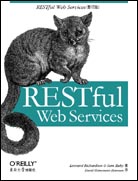
RESTful Web Services(影印版)
出版时间:2007年12月
页数:419
“每一位Web开发者都需要阅读这本书。”
—— David Heinemeier Hansson,Rails框架创始人
“《RESTful Web Services》为构建包含Web的Service提供了一张具有实际意义的发展路线图,而不是绕着目标兜圈子。”
—— Adam Trachtenberg,PHP作者及eBay公司Web Service传道者
你也许曾经建立过可供他人使用的网站,但是,你能否创建可供机器使用的网站?万维网(World Wide Web)不仅仅只是一个巨大的分布式应用——应该把它视为一个分布式计算平台。Web Service、聚合(mashup)和Ajax应用都以Web作为平台。而今天的Web Service技术早已失去了Web赖以成功的简洁性,它们并不像Web那样工作,并且正日益丧失其原有的优势。
本书让“Web”回归Web Service。它阐述了如何以你日常所使用的技术访问可编程的Web。其关键就在于REST,它是驱动Web的架构样式。本书包括以下内容:
· 强调Web基础技术的力量——HTTP应用协议、URI命名标准与XML标记语言
· 介绍面向资源的架构(ROA),设计RESTful Web Service的常识规则集合
· 揭示RESTful的设计如何比远程过程调用(RPC)更为简单、具有更多功能以及扩展性
· 包含RESTful Web Service的真实案例,如Amazon的简单存储服务与Atom发布协议等
· 探讨各种流行编程语言的Web Service客户端
· 展示如何用三种流行框架实现RESTful Service——Ruby on Rails、Restlet(基于Java)和Django(基于Python)
· 关注实际问题,诸如怎样设计和实现RESTful Web Service与客户端等
《RESTful Web Services》是对真实Web Service运用REST设计哲学的第一本书。它为你的成功设计树立了最佳实践典范,也为你提供了将设计转化为代码所需的技术。你不妨充分利用可编程Web的力量——只要与Web合作而不是与之抵抗。本书将教会你一切。
—— David Heinemeier Hansson,Rails框架创始人
“《RESTful Web Services》为构建包含Web的Service提供了一张具有实际意义的发展路线图,而不是绕着目标兜圈子。”
—— Adam Trachtenberg,PHP作者及eBay公司Web Service传道者
你也许曾经建立过可供他人使用的网站,但是,你能否创建可供机器使用的网站?万维网(World Wide Web)不仅仅只是一个巨大的分布式应用——应该把它视为一个分布式计算平台。Web Service、聚合(mashup)和Ajax应用都以Web作为平台。而今天的Web Service技术早已失去了Web赖以成功的简洁性,它们并不像Web那样工作,并且正日益丧失其原有的优势。
本书让“Web”回归Web Service。它阐述了如何以你日常所使用的技术访问可编程的Web。其关键就在于REST,它是驱动Web的架构样式。本书包括以下内容:
· 强调Web基础技术的力量——HTTP应用协议、URI命名标准与XML标记语言
· 介绍面向资源的架构(ROA),设计RESTful Web Service的常识规则集合
· 揭示RESTful的设计如何比远程过程调用(RPC)更为简单、具有更多功能以及扩展性
· 包含RESTful Web Service的真实案例,如Amazon的简单存储服务与Atom发布协议等
· 探讨各种流行编程语言的Web Service客户端
· 展示如何用三种流行框架实现RESTful Service——Ruby on Rails、Restlet(基于Java)和Django(基于Python)
· 关注实际问题,诸如怎样设计和实现RESTful Web Service与客户端等
《RESTful Web Services》是对真实Web Service运用REST设计哲学的第一本书。它为你的成功设计树立了最佳实践典范,也为你提供了将设计转化为代码所需的技术。你不妨充分利用可编程Web的力量——只要与Web合作而不是与之抵抗。本书将教会你一切。
- Foreword
- Preface
- 1. The Programmable Web and Its Inhabitants
- Kinds of Things on the Programmable Web
- HTTP: Documents in Envelopes
- Method Information
- Scoping Information
- The Competing Architectures
- Technologies on the Programmable Web
- Leftover Terminology
- 2. Writing Web Service Clients
- Web Services Are Web Sites
- del.icio.us: The Sample Application
- Making the Request: HTTP Libraries
- Processing the Response: XML Parsers
- JSON Parsers: Handling Serialized Data
- Clients Made Easy with WADL
- 3. What Makes RESTful Services Different?
- Introducing the Simple Storage Service
- Object-Oriented Design of S3
- Resources
- HTTP Response Codes
- An S3 Client
- Request Signing and Access Control
- Using the S3 Client Library
- Clients Made Transparent with ActiveResource
- Parting Words
- 4. The Resource-Oriented Architecture
- Resource-Oriented What Now?
- What's a Resource?
- URIs
- Addressability
- Statelessness
- Representations
- Links and Connectedness
- The Uniform Interface
- That's It!
- 5. Designing Read-Only Resource-Oriented Services
- Resource Design
- Turning Requirements Into Read-Only Resources
- Figure Out the Data Set
- Split the Data Set into Resources
- Name the Resources
- Design Your Representations
- Link the Resources to Each Other
- The HTTP Response
- Conclusion
- 6. Designing Read/Write Resource-Oriented Services
- User Accounts as Resources
- Custom Places
- A Look Back at the Map Service
- 7. A Service Implementation
- A Social Bookmarking Web Service
- Figuring Out the Data Set
- Resource Design
- Design the Representation(s) Accepted from the Client
- Design the Representation(s) Served to the Client
- Connect Resources to Each Other
- What’s Supposed to Happen?
- What Might Go Wrong?
- Controller Code
- Model Code
- What Does the Client Need to Know?
- 8. REST and ROA Best Practices
- Resource-Oriented Basics
- The Generic ROA Procedure
- Addressability
- State and Statelessness
- Connectedness
- The Uniform Interface
- This Stuff Matters
- Resource Design
- URI Design
- Outgoing Representations
- Incoming Representations
- Service Versioning
- Permanent URIs Versus Readable URIs
- Standard Features of HTTP
- Faking PUT and DELETE
- The Trouble with Cookies
- Why Should a User Trust the HTTP Client?
- 9. The Building Blocks of Services
- Representation Formats
- Prepackaged Control Flows
- Hypermedia Technologies
- 10. The Resource-Oriented Architecture Versus Big Web Services
- What Problems Are Big Web Services Trying to Solve?
- SOAP
- WSDL
- UDDI
- Security
- Reliable Messaging
- Transactions
- BPEL, ESB, and SOA
- Conclusion
- 11. Ajax Applications as REST Clients
- From AJAX to Ajax
- The Ajax Architecture
- A del.icio.us Example
- The Advantages of Ajax
- The Disadvantages of Ajax
- REST Goes Better
- Making the Request
- Handling the Response
- JSON
- Don't Bogart the Benefits of REST
- Cross-Browser Issues and Ajax Libraries
- Subverting the Browser Security Model
- 12. Frameworks for RESTful Services
- Ruby on Rails
- Restlet
- Django
- A. Some Resources for REST and Some RESTful Resources
- Standards and Guides
- Services You Can Use
- B. The HTTP Response Code Top 42
- Three to Seven Status Codes: The Bare Minimum
- 1xx: Meta
- 2xx: Success
- 3xx: Redirection
- 4xx: Client-Side Error
- 5xx: Server-Side Error
- C. The HTTP Header Top Infinity
- Standard Headers
- Nonstandard Headers
- Index
书名:RESTful Web Services(影印版)
作者:Leonard Richardson, Sam Ruby 著
国内出版社:东南大学出版社
出版时间:2007年12月
页数:419
书号:978-7-5641-0960-8
原版书出版商:O'Reilly Media
The animal on the cover of RESTful Web Services is a vulpine phalanger (P. vulpina).
Phalanger is the general term given to animals of the Phalangeridae family, which includes possums and cuscuses. (One should not confuse the Australian possum with the American opossum; they are both marsupials, but very different.) The term phalanger is derived from the Greek word phalanges, which means finger or toe bone. The omnivorous phalanger uses its claw-fingered paws (with opposable thumbs) to climb,hunt, and live in trees. Phalangers are found in the forests of Australia, New Zealand,Tasmania, and some Indonesian islands. Like the most famous marsupial, the kangaroo,female phalangers carry their young around in a front pouch after birth.
Phalanger is also the name of a PHP complier project for the .NET framework.
Phalanger is the general term given to animals of the Phalangeridae family, which includes possums and cuscuses. (One should not confuse the Australian possum with the American opossum; they are both marsupials, but very different.) The term phalanger is derived from the Greek word phalanges, which means finger or toe bone. The omnivorous phalanger uses its claw-fingered paws (with opposable thumbs) to climb,hunt, and live in trees. Phalangers are found in the forests of Australia, New Zealand,Tasmania, and some Indonesian islands. Like the most famous marsupial, the kangaroo,female phalangers carry their young around in a front pouch after birth.
Phalanger is also the name of a PHP complier project for the .NET framework.
购买选项